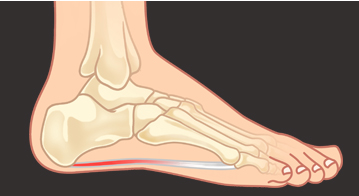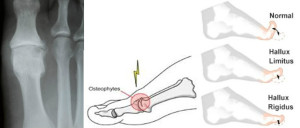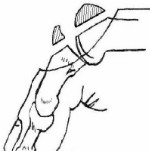
What is Hallux Limitus?
Hallux limitus refers to a condition where big toe joint (first MPJ) lost its range of motion. Hallux limitus encompasses mild to severe degenerative changes in the first MPJ and symptoms varies from mild to disabling. As our big toe joint plays an important role in walking, the limited motion of first MPJ may impact on normal forward gait movement which may lead to more proximal symptoms such as knee, hip or back pain.
What causes Hallux Limitus?
There are no definite causes of hallux limitus. Common causes of this condition are as follow:
- Faulty function (biomechanics) and structural abnormalities of the foot: fallen arches or excessive pronation are susceptible to developing hallux limitus
- Previous injury to the big toe joint
- Overuse: among people engaged in activities or jobs that increase the stress on the big toe joint such as workers who have to stoop or squat
- Frequent wearing of high heel shoes or shoes that are too tight
- Stubbing the big toe / Dropping a heavy object on the big toe joint
- Inflammatory arthritis – Rheumatoid arthritis, gouty arthritis

Conservative Treatments
Self-care at home: it should aim to reduce the inflammation, swelling and pain in the big toe and its joint.
- Rest the foot by putting the weight off the joint.
- Wear shoes with a rigid sole (to reduce the big toe joint from bending), wide and deep toebox, no raised heel (to reduce compression of the cartilage in the big toe joint).
- Soaking the foot in warm water can help soothe the inflamed and painful joint.
- Gentle massage with topical anti-inflammatory gel.
Professional treatments
- Anti-inflammatory/pain medications
- Orthotics to compensate for abnormal pronation or sometimes limit the motion at the big toe joint
- Steroid injection

Surgical Treatments
Do I need surgery?
In most mild cases, conservative treatments such as orthoses, shoe and activity modifications can relieve pain and discomfort. Surgery is recommended if these conservative treatments have failed to improve symptoms.
What does surgery involve?
Depending on the symptoms and severity of the deformity, surgical procedures vary.
Cheilectomy: usually recommended for mild to moderate deformity and aims to increase the range of motion by removing bone spurs and portion of bone to allow more room for the toe to bend and alleviate pain.Arthrodesis: It is recommended for moderate to severe hallux limitus where joint damage is severe. In this procedure, the damaged cartilage is removed from both sides of the joint and two bones are fused together with screws and/or plate. It mainly aims to eliminate the arthritis and pain.
Anaesthetics: Various anaesthetics are available (General or spinal block or local anaesthetics with sedation).
After Surgery
- Keep your foot elevated as much as possible and apply an ice pack for the first week following surgery
- Your dressing will be changed between 3-7 days at the office after surgery
- Keep your dressing dry for the first 2 weeks after surgery
- Sutures will be removed between 2-3 weeks after surgery
- You are able to weight-bear on the heel or outside part of your foot in the postop surgical shoes
- You need expect to wear postop surgical shoes for 2-4 weeks or longer for arthrodesis procedure


